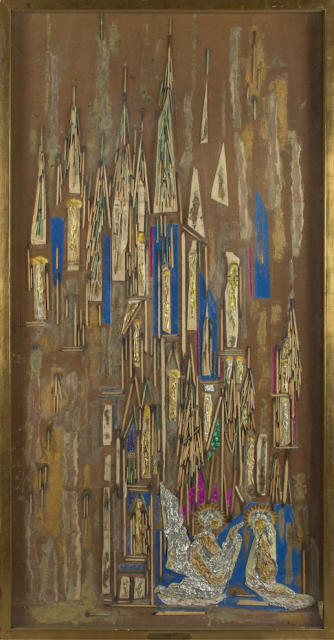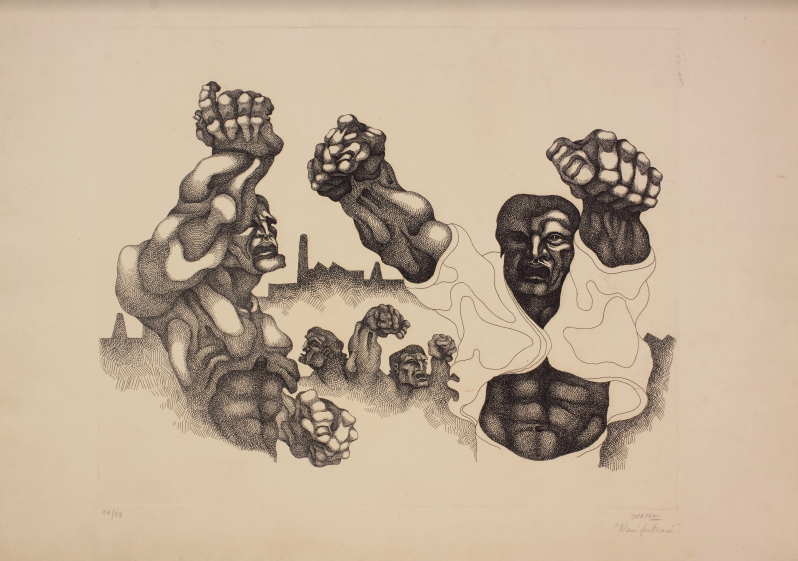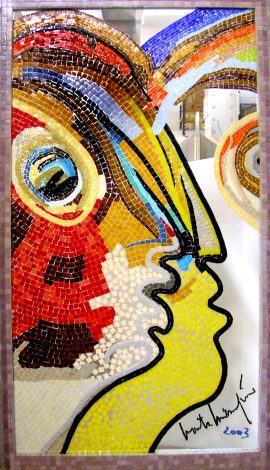There are several amazing aspects of this work, taking it into consideration alongside the other abstract works by Yente from the 1930s, 1940s and 1950s that are also part of the Museo Moderno’s collection. A founding member of the Agrupación de Arte No Figurativo [Non-Figurative Art Group], Yente was one of the first abstract artists and an outstanding figure in the history of art, along with Lidy Prati, another female artist who also worked under a pseudonym. She, however, always worked as a figurative artist.
What about religious themes? Curiously, in the 1960s Yente participated, on the one hand, in the First International Exhibition of Modern Art at our museum and, on the other hand, in the Sacred Art of Argentina exhibition in Rome. A few years later, she presented her “Antiguo Testamento” [Old Testament] series, which was made using the same technique as this particular collage.
This piece,donated by the Fondo Nacional de las Artes in 1966, uses a technique that Yente had already been experimenting with for twenty years. However, during these years, she began incorporating burnt matches and packaging paper made in Italy.
The patriarch Nikephoros, a detractor of the iconoclasts, said, “God is an infinite sphere whose centre is everywhere and whose circumference is nowhere.” This piece seems to contain abstraction, religion and iconophilism.
Yente (Eugenia Crenovich), Duomo l’annunziata, 1962, balsa wood, matches and paper clippings on hardboard, 119 x 60 cm. Donated by the Fondo Nacional de las Artes. 1966

For the reopening of the Museo Moderno, Diana Aisenberg created two works that were conceived specifically for the museum’s circulation areas. Zaguán y besos [Hallway and kisses] is a large installation that begins at the ground floor entrance. Its portal-like shape bids visitors welcome and transforms the physical boundary between the exterior and interior
of the museum. The hallway installation filters the light entering from the courtyard, transforming it into warm colors. The sharp vibrations of the sounds of the threads rubbing against each other in the wind call out, as if summoning people to come. The second installation, Totema [Female Totem], on the second floor of the museum, is a four-eyed entity, a monumental presence that rises up between the galleries. With its echoes of a deity dressed in ceremonial clothing, it pulses with the force of a living being.
We invite you to tour Nicanor Aráoz: Solid Sleep with the artist and Lucrecia Palacios, the exhibition curator.
This show was made possible thanks to the generous support of
Eloísa Haudenschild.
In this interview, Nicanor Aráoz and Lucrecia Palacios discuss the process of producing Nicanor Aráoz: Sueño sólido [Nicanor Aráoz:Solid Sleep], the exhibition that opened in October at the Moderno. How was the show conceived? How did the context of lockdown influence the installation and opening of the exhibit? What are the themes and interests the artist delves into in Sueño sólido?
Watch the video!

We cannot say for sure if the Gran estación de servicio [Large Service Station] painted by Bayón’s Edward Hopper was a YPF, but we can certainly imagine our energy sovereignty handed over to foreign interests yet again, back in 1982, the year the work was created. If we had to name one figure who defended national sovereignty, it would be Enrique Mosconi (1877-1940), who held a civil engineering degree from the University of Buenos Aires and a military engineering degree from the Technical Academy of Prussia. Mosconi was the promoter and organizer of expeditions to explore of the oil reserves in Argentina. He was also the first general director of Yacimientos Petrolíferos Fiscales (YPF), serving from 1922 until the military coup of 1930. For Mosconi, sovereignty and nationality were forged through the work of citizens, who were the main defenders of Argentina’s heritage and natural resources. In his 1929 book El petróleo argentino y la ruptura de os trusts petrolíferos inglés y norteamericano , he set out his ideas, which centred on a “closed door” policy and state monopoly that, in his words, “will end the fight between the trusts and YPF”.
Jorge Bayón, Gran estación de servicio [Large Service Station], 1982, oil on chipboard, 59 x 82 cm
Sobre las islas Malvinas, Georgias del Sur y Sandwich del Sur y los espacios marítimos e insulares correspondientes a la Guerra de Malvinas
In 1982, Marta Minujín made an anthropophagic performance project, Margaret Thatcher de Corned Beef [Corned Beef Margaret Thatcher]. The figure of the British Prime Minister, known as the “Iron Lady”, was represented by a 17-metre-high iron structure; The image was completed with dozens of cans of corned beef mounted on its exterior and stuffed with cotton to be burned after the meat had been distributed to the public.
In 1982, Argentina was ruled by a dictatorship under the command of Lieutenant General Leopoldo Fortunato Galtieri. Days before the Argentine landing in Malvinas, on 2 April, the workers’ movement called for a march on Plaza de Mayo, where fifty thousand people crowded together to chant the slogan “peace, bread and work”, amidst insults to the dictator. The patriotic call for the recovery of the islands, illegally occupied by the United Kingdom since 1833, was a clear strategy to neutralize any popular demands. Argentina continues to reaffirm its sovereignty in accordance with international law, asserting that the recovery of the islands is a permanent and unwavering objective.
Marta Minujín, Margaret Thatcher de Corned Beef [Corned Beef Margaret Thatcher] (project), 1982, ink on paper, 100 x 69 cm. Donated by the Asociación Argentina de Críticos de Arte, 1988


Ricardo Carpani developed an iconography that made the worker the protagonist. He participated in the Espartaco Movement and later had close relationships with the trade unions, creating murals, graphic designs, posters, holding workshops and creating workers’ and militant publications. He was also a prolific writer and was politically active on the national left and as a backer of revolutionary Peronism.
One of his central interests was the debate on whether Latin American art was sovereign and popular or dependent and colonized. Carpani would say, “If it is the masses who produce our national culture on a daily basis through their decolonizing political struggle, why shouldn’t they be in charge of embodying that culture in images? Why should such a task necessarily be the exclusive responsibility of specialists (artists) trained as such, outside of that process and in the colonized academies and circles of the very system the masses are trying to destroy and overcome through their struggle?”
Ricardo Carpani, Arte y militancia, Buenos Aires, Ediciones Continente/ Peña Lillo, 2010, p. 82
Ricardo Carpani (1930-1997), Manifestación [Demonstration], undated, intaglio etching, 40, 5 x 49.5 cm. Edition 14 of 75

The Moderno Children’s Council meets to contemplate and share the wishes and needs of children. At our previous meetings, we have based our work on asking the following questions: What object would you take with you on a trip around the world and why? What is your favorite space and which one would you not go back to? What kind of museum would you like to open?
This time, you can help us by answering the following questions on a sheet of paper of your favorite colour: What advice would you give to adults to improve the present and the future? You can think about what you would like to transform in your neighbourhood, school or city. If you like, you can also record a short video.
Upload it to your social media account with your name and age. We are going to create a “Mosaic of childhood” and, with everyone’s contribution, we will put together the voice of the children of the Moderno. Don’t forget to tag the museum! If you want to be part of Museo Moderno’s Children’s Council, sign up at www.museomoderno.org
Artwork: Marta Minujín, Imaginando estupor [Imagining Stupor], 2003, venetian tiles glued on glass with iron frame, 210 x 110 x 7 cm. Donated by the Asociación Amigos del Museo de Arte Moderno, 2009
A Creative Tutorial by Gonzalo Prieto
Draw a superheroine or superhero of the Museo de Arte Moderno de Buenos Aires! Imagine you are a comic book character and you use the museum as your base of operations. What would your super power be? Who would be your enemy? What would be the dangers threatening the works of art or the museum’s visitors? How would you protect them?
Don’t forget to share your character in “stories” and tag the Museum, we’ll be sharing them over the weekend!
Mildred Burton claimed that her father could fly off the roof of their house with chickens under his arm, that her son swam with crocodiles, that in the middle of Buenos Aires she had collided with a giant animal, and that her grandmother had hanged her childhood cat. Regardless of whether these stories are true or even plausible, Mildred Burton’s life and work were always filled with the disturbing presence of animals. Whether crouched behind a human form in a harmonious coexistence, or crawling menacingly among us, Burton’s works from the modern past raise a debate on culture and nature that continues to concern us today, in the 21st century. Burton’s mutant images undermine the boundaries built between humans and other animals. Yet Mildred did not understand them as purely tender and peaceful bonds. On the contrary, her images are charged with varying doses of irony, cruelty and fantasy, and it is in that combination that she produced a reading of the country she lived in.